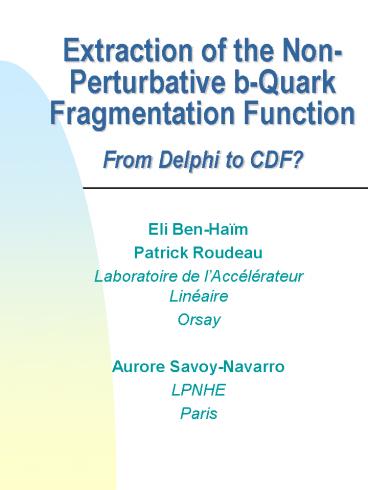Extraction of the Non-Perturbative b-Quark Fragmentation Function From Delphi to CDF? - PowerPoint PPT Presentation
1 / 14
Title:
Extraction of the Non-Perturbative b-Quark Fragmentation Function From Delphi to CDF?
Description:
Extraction of the Non-Perturbative b-Quark Fragmentation Function. From Delphi to CDF? ... Unphysical regions in perturbative distribution from theory. ... – PowerPoint PPT presentation
Number of Views:27
Avg rating:3.0/5.0
Title: Extraction of the Non-Perturbative b-Quark Fragmentation Function From Delphi to CDF?
1
Extraction of the Non-Perturbative b-Quark
Fragmentation FunctionFrom Delphi to CDF?
- Eli Ben-Haïm
- Patrick Roudeau
- Laboratoire de lAccélérateur Linéaire
- Orsay
- Aurore Savoy-Navarro
- LPNHE
- Paris
2
Introduction
- b-quark fragmentation in ee- annihilation
- Definitions
- the variable x
- Measured fragmentation function
3
- D can be split into a perturbative and a
non-perturbative components - Perturbative- Calculable within perturbation
theory bb pair production, gluon radiation. - Monte Carlo simulation.
- Theoretical calculation.
- Non-perturbative- hadronisation, all the
contributions that are not included in the
perturbative part. - Main perspective using the non-perturbative
component in CDF.
4
- Recent results from Aleph (May 2001), SLD (May
2002), Delphi (not published) and OPAL (October
2002). - Average lt 1995 0.702 ?0.008
- Mean values
- Aleph 0.716?0.006?0.006
- SLD 0.709 ?0.003 ?0.003 ?0.002(model)
- Delphi 0.7153?0.0007?0.0051
- OPAL 0.7193 ?0.0016 ?0.0034
5
Subjects to be presented
- New method direct extraction of the
non-perturbative QCD component of the b-quark
fragmentation function. - Perspectives.
6
Direct Extraction of the Non-Perturbative QCD
Component
- The usual approach taking a functional form for
the non-perturbative component (Peterson, Lund). - We propose an alternative approach
- The perturbative and non-perturbative
distributions of the variable x are folded by - If applying to both perturbative and
non-perturbative distributions the Mellin
transformation - (simple moments for integer N).
- Folding the distributions becomes simply
7
- The last expression allows us to extract the
non-perturbative component in the N-space (Mellin
conjugate space). - It is a simple ratio.
- and then, we bring it back to the x-space by
taking the inverse Mellin transformation
Direct, model independent method to obtain the
non- perturbative component.
- This can be done for perturbative component
- From Monte Carlo.
- From Theoretical QCD calculation.
8
The N-space distributions
Nth moment value (D(N), Dpert(N)
9
About the Theoretical QCD Calculation
Cacciari and Catani Nucl.Phys. B617 (2001)
253-290.
- Resummation of Large logarithmic terms (up to
NLL) to all perturbative orders in ?s. - Generalization of previous calculations adding
soft gluons contributions at large x. - Calculations are done in Mellin conjugate space.
- Factorization of process dependent and process
independent functions in the N distribution
?0 leading order cross section.
C process dependent coefficient function.
DNgluons perturbative gluon radiation. E
AP evolution operator.
DNgluons,ini initial condition.
- Calculation is reliable for N not too large.
10
Further comments for the theoretical calculation
x-distribution
- Contains non-physical parts. Not under control in
the large x region due to discrepancies at large
N. - Slightly distorted (even when physical) by the
large x (large N) behavior.
Scale and parameter dependence
Nth moment value Dpert(N)
11
Results
Corresponding to perturbative components from
Monte Carlo
Theoretical QCD
Dpert(x), DNP(x)
- Non-physical region at low x due to
- Unphysical regions in perturbative distribution
from theory. - A problem in the perturbative component from the
Monte Carlo or in the measured distribution.
The Non perturbative function may be used in a
different environment than ee- collisions, only
in the framework of a similar perturbative
assumptions as were used for its extraction.
12
If we cancel the non-physical part in the MC
non-perturbative component
The measured function becomes
The perturbative component becomes
Dpert(x)
Dmeasured(x)
13
Comparing with models
- Model parameters are those who best fit Delphis
data.
Perturbative component from Monte Carlo
Perturbative component from Theory
Dpert(x), DNP(x)
- The extracted non-perturbative component does not
look like the common models, especially for the
theory.
14
perspectives
- Completing our measurement.
- How to implement in CDF?
- Model independent method check on other domains
of energy for ee-. - Check for charm fragmentation.
- Study the properties of the leading track
accompanying the B.

